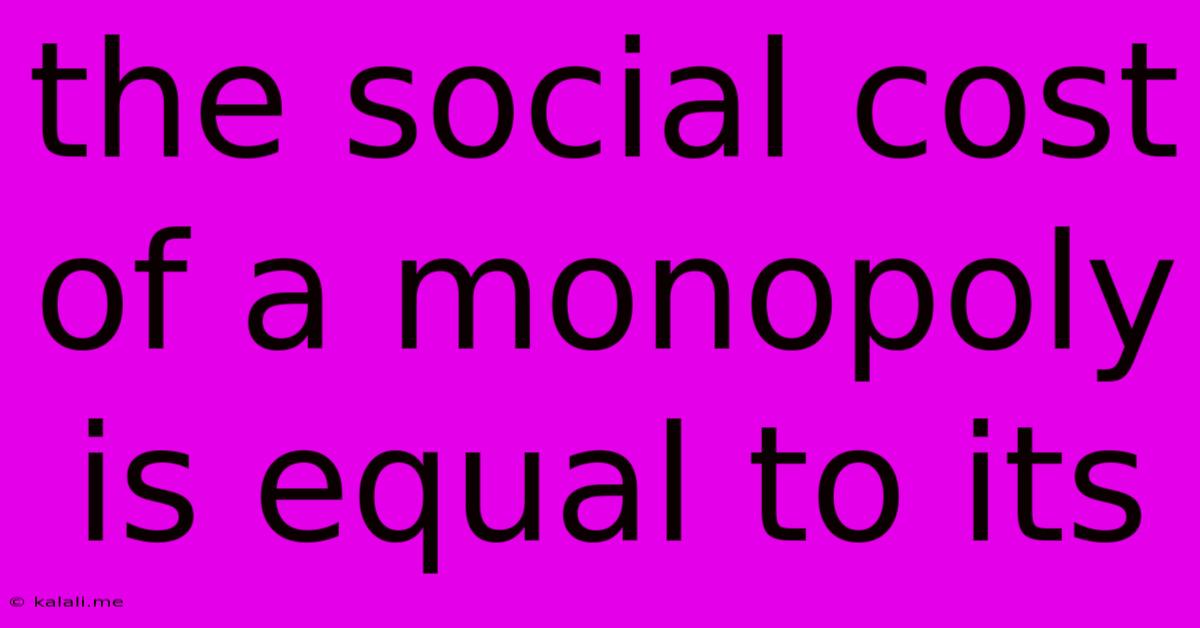The Social Cost Of A Monopoly Is Equal To Its
Kalali
Jun 14, 2025 · 3 min read

Table of Contents
The Social Cost of a Monopoly is Equal to its Deadweight Loss
The social cost of a monopoly is a crucial concept in economics, representing the overall negative impact a monopoly has on society. This cost isn't simply the profits the monopolist earns, but rather the deadweight loss – a measure of the lost economic efficiency that results from a market not operating at its competitive equilibrium. This article will delve into understanding deadweight loss, exploring why it represents the social cost of a monopoly, and examining its implications.
What is Deadweight Loss?
Deadweight loss signifies the reduction in economic efficiency that can occur when equilibrium for a good or service is not Pareto optimal. In simpler terms, it's the loss of potential economic benefits due to market inefficiencies. Think of it as the value of transactions that could have occurred but didn't because of the monopoly's actions. This lost value represents a societal cost, as resources are not allocated to their most efficient uses.
Monopolies and Deadweight Loss: A Deeper Dive
A perfectly competitive market achieves allocative efficiency. This means that resources are allocated to produce the goods and services that consumers value most. The price reflects the marginal cost of production. However, a monopoly restricts output to increase prices and maximize profits. This leads to a situation where:
- Quantity produced is lower: Monopolies restrict supply to keep prices artificially high.
- Price is higher: Consumers pay more than they would in a competitive market.
- Consumer surplus is reduced: Consumers lose because they pay higher prices and consume less.
- Producer surplus is increased (but not by the full amount): The monopolist gains, but this gain is less than the combined loss to consumers.
- Deadweight loss emerges: This represents the net loss to society – the difference between what could have been produced and consumed and what is produced and consumed due to the monopoly's actions. This is the triangle of inefficiency on supply and demand graphs.
Why Deadweight Loss Equals the Social Cost
The social cost of a monopoly isn't merely the profit the monopolist earns. While the monopolist benefits, the loss to consumers and the overall inefficiency outweigh these gains. The deadweight loss precisely quantifies this net loss to society. It represents the lost consumer surplus and producer surplus that would have existed in a competitive market. It signifies the misallocation of resources – goods and services that consumers value are not being produced because the monopolist restricts output to maximize its own profit.
Factors Influencing Deadweight Loss
The magnitude of the deadweight loss depends on several factors, including:
- The price elasticity of demand: If demand is highly elastic (meaning consumers are very responsive to price changes), the deadweight loss will be larger because the quantity reduction will be substantial.
- The degree of market power: A monopoly with more market power will generally lead to a larger deadweight loss.
- The cost structure of the monopolist: The shape of the cost curve influences how much the monopolist restricts output.
Policy Implications
Understanding the social cost of a monopoly, as represented by its deadweight loss, has significant policy implications. Governments often intervene to mitigate the negative effects of monopolies through:
- Antitrust laws: These laws aim to prevent monopolies from forming and to break up existing ones.
- Regulation: Governments can regulate prices and output to ensure that monopolies don't exploit their market power excessively.
In conclusion, the social cost of a monopoly isn't just about profits; it's fundamentally about the deadweight loss – the inefficiency and lost potential benefits to society. This concept highlights the importance of competition in ensuring efficient resource allocation and maximizing overall social welfare. Understanding deadweight loss allows for better policy decisions aimed at fostering competitive markets and minimizing the negative consequences of monopolies.
Latest Posts
Latest Posts
-
How Many Square Yards Is One Acre
Jun 15, 2025
-
The Storage Form Of Carbohydrates In Animals Is
Jun 15, 2025
-
What Organelles Have Their Own Dna
Jun 15, 2025
-
Does Western Washington University Require Sat
Jun 15, 2025
-
Compare And Contrast Dependent And Independent Variables
Jun 15, 2025
Related Post
Thank you for visiting our website which covers about The Social Cost Of A Monopoly Is Equal To Its . We hope the information provided has been useful to you. Feel free to contact us if you have any questions or need further assistance. See you next time and don't miss to bookmark.